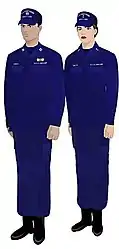Uniforms of the United States Coast Guard Auxiliary
The uniforms of the United States Coast Guard Auxiliary serve to distinguish Auxiliarists from members of other civilian military auxiliaries and of other armed services.
Each auxiliary uniform is identical to a Coast Guard officer's military uniform, with the exception that the buttons and stripes on dress jackets and shoulder boards are silver in color, rather than gold.
History
Prior to 1972, all Coast Guard personnel, including Auxiliarists, wore the same uniforms as the United States Navy, with distinctive Coast Guard insignia. In 1972, Commandant of the Coast Guard Admiral Chester R. Bender introduced a new set of blue uniforms for wear by all personnel, which were also adopted by the Auxiliary.
Unlike Navy uniforms, the new "Bender's blues" uniforms made few distinctions between officers and enlisted personnel, with all ranks generally wearing the same style of uniform (with the exception of a few formal uniforms reserved for officers only).
Dress uniforms
Auxiliarists generally wear the same dress and service uniforms as active duty personnel, but with Auxiliary-specific insignia and (on dress uniforms) silver buttons and braid instead of gold. Previously, this included the white "choker" uniform but these uniforms are no longer authorized for Auxiliarists. Additionally, because the Auxiliary does not award full-sized versions of its medals, Auxiliarists are de facto precluded from wearing the Full Dress Blue uniform.
Service dress uniforms
 Service Dress Blue
Service Dress Blue Service Dress White (No Longer Authorized)
Service Dress White (No Longer Authorized)
Service uniforms
 Winter Dress Blue
Winter Dress Blue Tropical Blue
Tropical Blue
Dinner dress uniforms
 Dinner Dress Blue Jacket
Dinner Dress Blue Jacket Dinner Dress White Jacket
Dinner Dress White Jacket Dinner Dress Blue
Dinner Dress Blue Dinner Dress White (No Longer Authorized)
Dinner Dress White (No Longer Authorized)
Civilian variant
For those Auxiliarists who do not wish to wear military-style dress uniforms, an "Auxiliary blue blazer outfit," is authorized, which is similar in style to a yacht club uniform. It consists of a navy blue blazer with an Auxiliary crest, white shirt or blouse, navy tie, grey or white dress trousers or skirt, and black dress shoes. The blazer outfit is particularly encouraged, but not strictly required, for those Auxiliarists who do not meet Coast Guard height, weight, and grooming standard.
Working uniforms
Auxiliarists also have several distinctive working uniforms and optional uniform items not authorized for active duty personnel.
Operational Dress Uniform
 Operational Dress Uniform (ODU)
Operational Dress Uniform (ODU) Flight Suit[1]
Flight Suit[1]
Auxiliarists wear the Operational Dress Uniform (ODU) as the standard working uniform. The ODU is similar to the old Battle Dress Uniform, both in function and style, but is a solid dark blue color, rather than camouflage, and lacks lower pockets on the blouse. In the fall of 2008 a second-generation Operational Dress Uniform was introduced, with the major change being that the top is worn on the outside of, rather than tucked into, the trousers.
Composite toe boots are the standard footwear, but brown leather boat shoes may be (and frequently are) prescribed for wear while aboard boats.
A baseball cap-style cover, with "U.S. Coast Guard Auxiliary" embroidered in silver block lettering, is worn with the ODU. There is also an optional broad-brimmed "sun hat" available.
Auxiliary-specific variants
The "Hot Weather Uniform," which is no longer authorized for active duty personnel due to its non-military appearance, remains in service with the Auxiliary.The Hot Weather Uniform consists of the ODU t-shirt, dark blue cargo shorts, and baseball cap. Either brown leather boat shoes or black ankle boots may be worn.
A dark blue "operational polo shirt" may be worn in lieu of the ODU top and t-shirt with the ODU and the Hot Weather Uniform. The operational polo shirt is a navy blue polo shirt with "USCG AUXILIARY" embroidered on the left breast and the wearer's named embroidered on the right breast, similar to the ODU top.
A "Vessel Examiner polo shirt" is also available for Auxiliarists conducting vessel safety checks. The VE polo was previously a shade of light blue but was redesigned and made available in both white and dark blue in 2020.
External links
| Wikimedia Commons has media related to USCGAUX Uniforms. |
